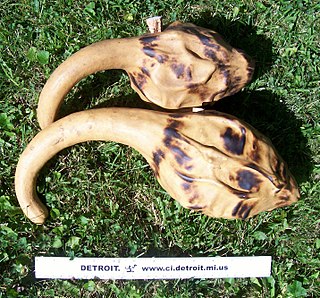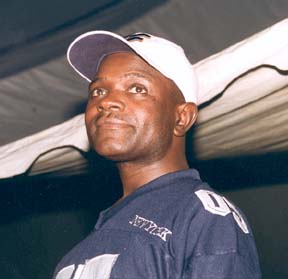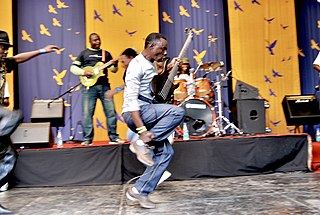
The tambourine is a musical instrument in the percussion family consisting of a frame, often of wood or plastic, with pairs of small metal jingles, called "zills". Classically the term tambourine denotes an instrument with a drumhead, though some variants may not have a head. Tambourines are often used with regular percussion sets. They can be mounted, for example on a stand as part of a drum kit, or they can be held in the hand and played by tapping, hitting, or shaking the instrument.
The music of Trinidad and Tobago is best known for its calypso music, soca music, chutney music, and steelpan. Calypso's internationally noted performances in the 1950s from native artists such as Lord Melody, Lord Kitchener and Mighty Sparrow. The art form was most popularised at that time by Harry Belafonte. Along with folk songs and African- and Indian-based classical forms, cross-cultural interactions have produced other indigenous forms of music including soca, rapso, parang, chutney, and other derivative and fusion styles. There are also local communities which practice and experiment with international classical and pop music, often fusing them with local steelpan instruments.

Zimbabwean music is heavily reliant on the use of instruments such as the mbira, Ngoma drums and hosho. Their music symbolizes much more than a simple rhythm, as the folk and pop style styled music was used as a symbol of hope for Zimbabweans looking to gain independence from Rhodesia. Music has played a significant role in the history of Zimbabwe, from a vital role in the traditional Bira ceremony used to call on ancestral spirits, to protest songs during the struggle for independence. The community in Zimbabwe used music to voice their resistance to their oppression, as one of the only weapons they had available to fight back with. In the eighties, the Music of Zimbabwe was at the center of the African Music scene thanks to genres such as Sungura and Jit. However, several performers were banned by state TV and radio leading to the closing of several music venues.

The hosho are Zimbabwean musical instruments consisting of a pair of maranka (mapudzi) gourds with seeds. They are used as major instruments in many traditional Shona music genres, such as in mbira ensembles and in mhande. They typically contain hota seeds inside them. Before the hota seeds are added, the hosho is boiled in salted water and the inside is scraped out with a corncob, newspaper plug, or woven wire. Removing the debris inside the hosho allows for a more sharp and percussive tone.
Eurodance is a genre of electronic dance music that originated in the late 1980s in Europe. It combines many elements of rap, techno and Eurodisco. This genre of music is heavily influenced by the use of rich vocals, sometimes with rapped verses. This, combined with cutting-edge synthesizers, strong bass rhythm and melodic hooks, establishes the core foundation of Eurodance music.

The music of Suriname is known for kaseko music, and for having an Indo-Caribbean tradition.
Shona music is the music of the Shona people of Zimbabwe. There are several different types of traditional Shona music including mbira, singing, hosho and drumming. Very often, this music will be accompanied by dancing, and participation by the audience. In the Shona style of music, there is little distinction between the performer and the audience. Both are often actively involved in the music-making and both are important in the Shona religious ceremonies.

Dappankuthu is a folk dance and music genre, that is typically danced to the Gaana music genre or Kuthu Beats with an emphasis on percussion performed in the South Indian state of Tamil Nadu. It is one of several popular genres employed in film music, mainly in Tamil cinema and other South films, filmed and produced by people of Tamil culture. It is related to name Teenmaar music in Telugu states.
Ephat Mujuru (1950–2001), was a Zimbabwean musician, one of the 20th century's finest players of the mbira, a traditional instrument of the Shona ethnic group of Zimbabwe.

Stepping or step-dancing is a form of percussive dance in African-American culture. The performer's entire body is used as an instrument to produce complex rhythms and sounds through a mixture of footsteps, spoken word, and hand claps. Though stepping may be performed by an individual, it is generally performed by groups of three or more, often in arrangements that resemble military formations.

Simon Chimbetu was a Zimbabwean guitarist, vocalist and composer. He was the founding member of his band Orchestra Dendera Kings. He was known by many stage names, including "Chopper, "Mr Viscose", "Cellular", "Simomo" and "Mukoma Sam".
A bélé is a folk dance and music from Dominica, Grenada, Guadeloupe, Haiti, Martinique, Saint Lucia, and Trinidad and Tobago. It may be the oldest Creole dance of the creole French West Indian Islands, and it strongly reflects influences from African fertility dances. It is performed most commonly during full moon evenings, or sometimes during funeral wakes. In Tobago, it is thought to have been performed by women of the planter class at social events in the planters' great houses, and the dress and dance style copied by the enslaved people who worked in or around these houses.
Lovemore Tshuma, commonly known as Lovemore Majaivana is a Zimbabwean musician, arguably the most Popular Ndebele singer, and by far the most prominent to have emerged from Bulawayo. He earned the stage name 'Majaivana' for his exceptional dancing.
Joseph Chinotimba is a Zimbabwean political figure. He rose to prominence during the invasions of white-owned commercial farms that started after the 2000 constitutional referendum in Zimbabwe. He is widely regarded as a militant ZANU-PF cadre with unquestionable allegiance to the old guard of the ruling party. He is the national vice-chairman of the Zimbabwe National Liberation War Veterans Association.
Tongai Moyo was a contemporary Zimbabwean musician, often referred to as Dhewa. Born and raised in Kwekwe, Dhewa rose to fame in the late 1990s as a solo artist and with the band Utakataka Express. Highly successful singles including "Samanyemba", "Naye", and "Muchina Muhombe" led to his national, regional and international fame; he produced 14 albums in a career of over twenty years.

Alick Macheso, is a Zimbabwean musician.

Prince Kudakwashe Musarurwa, was a Zimbabwean African jazz singer, songwriter, producer and musician.








